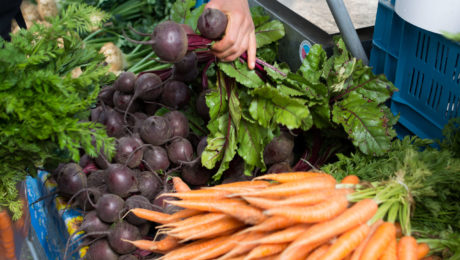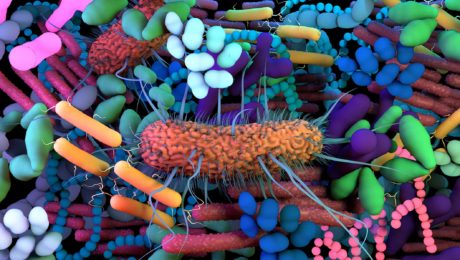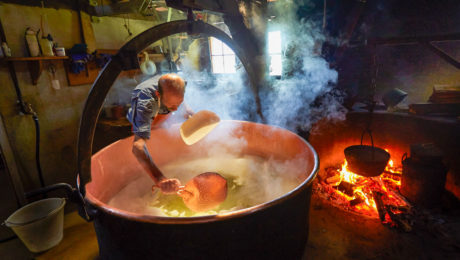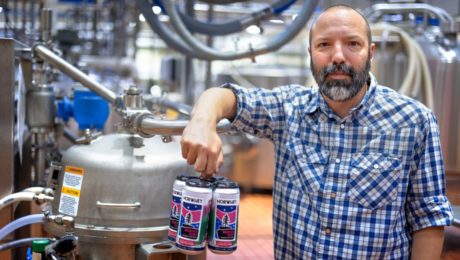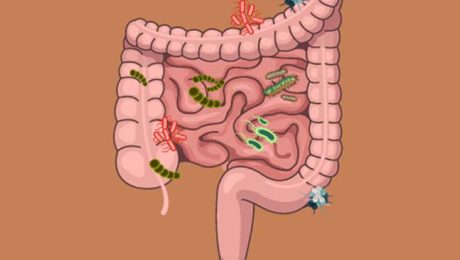Fermentation for Global Health
Though scientists and environmentalists have warned about the dangers of increased meat consumption, Americans’ appetite for it is not slowing down. The last three years marked the largest amount of meat produced on record.
“People know about the harms of industrial agriculture, but people eat more and more and more meat,” says Bruce Friedrich, CEO of the Good Food Institute (GFI). “It’s an inextricable rise despite more and more attention to the issues. The vast majority of people are just not going to apply ethical considerations to their food choices.”
Fermentation, Friedrich declares, can be part of the solution. “Fermentation can be so powerful for global health, climate and biodiversity,” he says.
Friedrich spoke at FERMENTATION 2022 on alternative protein innovation. GFI, a nonprofit, aims to accelerate the innovation of fermented, plant- and cell-based alternative meat. But the young, rapidly-growing alt protein industry faces major obstacles in scaling, regulation, pricing and consumer acceptance. Friedrich told a room of professional fermenters at the conference to consider shifting to a career in alternative proteins.
“Anyone involved in fermentation, you have the expertise in knowledge. It’s cross-applying the skills and interest in your professional life into this new field,” he says. “One of the significant barriers for all the companies doing this is talent, which is to say – you.”
Global Agriculture Crisis
Friedrich does not mince his words: we’re on the precipice of a major environmental and health crisis if we don’t reduce meat consumption.
Mass producing meat is “extraordinarily inefficient.” Huge amounts of crops are grown to feed livestock so humans can then eat the animals.. “We have been using an antiquated method to produce meat for 12,000 years,” Friedrich adds.
Internationally, 4 billion hectares of land are used for agriculture – 3 billion are for grazing livestock or to grow their food. It takes 9 calories of feed to produce 1 calorie of chicken; 40 calories to produce 1 calorie of beef.
“This is an incredibly inefficient way to try and feed the world,” Friedrich says.
And it’s getting worse. By 2050, global meat consumption is projected to increase – conservative estimates say 50%, while others go as high as 260%.
Animal agriculture also is thought to be a major contributor to global climate change and a major factor in deforestation. Livestock are pumped with antibiotics, creating resistance in humans that consume that meat.
Future of “Meat”
The answer isn’t necessarily a world of vegetarians – it’s to change traditional meat.
Friedrich compares the situation to renewable energy and electric vehicles. For decades, government leaders have preached reducing fossil fuel consumption. But, as populations have risen, so has energy consumption.
“You are not going to convince people to consume less energy,” he says. “What you need to do is replace fossil fuels with renewable energy.”
Similarly with meat, there cannot be a meatless world. “This is innovation focused, it is not about behavior change,” he says.
“GFI when we started, we were talking about disrupting animal agriculture. We very quickly realized our hope is to transform industrial animal agriculture,” he says. “Things will happen a lot more quickly if we have the major corporations on board.”
GFI is “enthusiastically working with the biggest companies in the world:” JBS, Tyson, Smithfield, Cargill and BRF, the five largest global meat producers.
The aim is not to regulate big agriculture or stop subsidies. GFI hopes to open access into the science behind alternative proteins, incentivize the private sector to continue R&D and encourage government funding.
“The same sort of cash breaks that allowed Tesla to be successful should apply to Nature’s Fynd and Impossible Foods and others if they want that money,” Friedrich says, listing two major companies in the alternative protein industry. “Our global battle cry is that governments should be funding alternative proteins.”
Food Trifecta
By not gatekeeping alt protein technology, Friedrich says GFI is helping perfect the process of giving consumers the exact same meat experience, but using plant- or cell-based meats. People want the food trifecta, Friedrich says: Is it delicious? Does it fill me up? Is it reasonably priced?
Fermentation is a booming sector in the alternative protein industry. It is split into three categories: traditional fermentation using lactic acid bacteria, yeasts or fungi; biomass fermentation which involves naturally occurring, protein-dense, fast-growing microorganisms; and precision fermentation, which uses microbial hosts as “cell factories” to produce specific ingredients.
Data from GFI found, of the alt protein startups utilizing fermentation, 45% use precision fermentation, 41% use biomass fermentation and the remaining 14% use traditional fermentation.
GFI recently hired two fermentation scientists, and their studies are already suggesting biomass and traditional fermentation will have better environmental numbers than plant-based meats. Fermentation is also a more powerful process than plant-based meat applications because fermentation can replicate precise fermentation proteins. And although traditional fermentation is the smallest part of the fermented alternative protein category, GFI sees it growing because of its ability to produce appealing flavors..
“Traditional fermentation can be an absolutely essential element to get meat to taste the same or better or cost the same or less,” he says.
“The plant based and fermentation products, they’re just getting started. The idea of competing with industrial animal meat has been around for (snaps his fingers) that long. The products are just going to improve and improve and improve.”
Does Organic vs. Conventional Matter for Fermented Foods?
Organic food is considered by some to be healthier and more nutritious than its conventional counterpart. But what about when that food is fermented? Does organic vs. conventional matter?
A new study reveals some surprising results: when it comes to fermented foods, “the quality of organic food is not always better than conventional food.”
Organic vs. conventional agricultural production is a hotly debated topic – some reports indicate organic food is more nutritious, but other research suggests the nutritional differences are not significant. Meanwhile, fermented foods are scientifically-proven to include higher nutritional value. “During fermentation, the concentration of many bioactive compounds increases, and the bioavailability of iron, vitamin C, beta carotene, or betaine is also improved,” the study notes. Fermented products also “inhibit the development of pathogens in the digestive tract.”
Researchers at the Bydgoszcz University of Science and Technology in Poland questioned whether fermenting organic food would change its nutritional output versus using conventional food. Their results were published in the journal Molecules.
Analyzing fermented plants (pickles, sauerkraut, beet and carrot juices) and dairy (yogurt, kefir and buttermilk), researchers measured the vitamins, minerals and lactic acid bacteria in the items. They compared using organic ingredients in one group to products made from conventional ingredients.
“Research results do not clearly indicate which production system–conventional or organic–provides higher levels of bioactive substances in fermented food,” the study reads.
Results were mixed. Lactic acid bacteria – the good, healthy kind – were higher in organic sauerkraut, carrot juice, yogurt and kefir. Organic kraut and pickles produced more vitamin C than conventional versions. And calcium levels were higher in yogurt made with organic milk.
But, interestingly, lactic acid bacteria levels were higher in conventional pickles and beet juice. Conventional beet juice also had five times more beta-carotene (vitamin A).
Read more (Molecules)
Harnessing the Power of the Microbiome
A team of nearly three dozen researchers from around the world reviewed case studies on microbiome research in agrifood systems. Their results, published in the journal Frontiers in Microbiology, “showcase the importance of microbiome research in advancing the agrifood system.”
Their 14 success stories include a broad range of topics within agrifood:
- Microbial dynamics in food fermentation
- Using microorganisms as soil fertilizers
- Applications to improve HACCP systems
- Identification of novel probiotics and prebiotics to prevent disease
- Using microbiomes of fermented foods for starter cultures
- Fermenting feed to improve the microbiomes of livestock
- Identifying microbes in fermented meats
- Using microbiota analysis for fermented dairy products
To further microbiome use in food systems, the research points to studies highlighting that fermented foods include many health-promoting metabolites (including studies by TFA Science Advisory Board member Maria Marco, a University of California, Davis, food science professor). But, the researchers stressed: “How certain microorganisms drive food fermentation, are transferred across the food production chain, persist in the final product and, potentially, colonize the human gut is poorly understood.” Researchers conclude that more work is needed to understand how the probiotics and metabolites in fermented foods could be used to treat diseases.
“Agrifood companies recognize the potential in understanding the microbiome and translating this knowledge into products,” the study continues. The food industry, the study notes, is “further preparing to develop personalized diets and specific foods for particular target groups in order to prevent or treat certain chronic conditions.”
“The microbiomes of soil, plants and animals are pivotal for ensuring human and environmental health. Research and innovation on microbiomes in the agrifood system are constantly advancing, and a better understanding of these microbiomes will be a key factor in producing highly nutritious, affordable, safe and sustainable food.”
Read more (Frontiers in Microbiology)
Infants Sleep More if Mom Eats Fermented Foods
Toddlers and infants slept 10 hours or more a night if their mother ate fermented foods while pregnant, according to a new Japanese study.
The results, published in the journal BMC Public Health, studied over 64,000 pairs of mothers and their children. The diet of pregnant mothers was found to have an impact on sleep length of their children. Pregnant women who consumed miso, yogurt, cheese and/or natto all had children that slept 10+ hours a night until the age of 3. The article calls it “fermentation for hibernation.”
The study notes, though, that there are other associated factors at play. The women consuming fermented foods were well-educated, employed and had higher incomes compared to the pregnant mothers not regularly consuming fermented foods. Scientists inferred that this higher demographic group “likely recognized factors that could contribute to health and chose nutrient-rich options [instead of] nutritionally-unbalanced food.”
Read more (NutraIngredients)
Can Science Improve Chocolate?
Just like wine and coffee, the flavors of chocolate come from the local terrain, climate and soil where the cacao bean is grown. Chocolates from various parts of the world all taste different. Can those tastes be replicated?
Scientists are trying to determine what produces those flavors and if they can reproduce them consistently. Irene Chetschik, professor in food chemistry at Zurich University of Applied Sciences, has developed “new technological processes that can impact cocoa flavor on a molecular level — to get the best out of each harvest and create consistent quality,” details an article in BBC.
Chetschik says: “Now there is more appreciation for the product – we know where the bean is coming from, which farm, which variety – we can experience a much wider flavor diversity.”
Cocoa beans traditionally are fermented where they are grown. Fermentation will affect quality – a poorly-fermented bean has little flavor; while an over-fermented bean can become too acidic.
Chetschik has developed a “moist incubation” fermenting technique where a lactic acid solution containing ethanol is applied to dried cocoa beans. It triggers the same fermentation reaction in the beans, “but is far easier to control,” she says. The final taste is sweet, rich and fruity.
Nottingham University is also working on a chocolate-enhancing project. They’re using a hand-held DNA sequencing device to analyze the cocoa bean microbes. “With improved understanding of what drives the taste of premium chocolate, fermentation can be manipulated for improved flavor.”
Read more (BBC)
- Published in Food & Flavor, Science
Domesticating Fermented Food Microbes
Humans have domesticated plants and animals since the early days of civilization, changing the life cycles, appearances and behaviors of crops and livestock. A new study shows humans have done the same to fermented products, selectively taming microbes. But as a result, microbial strains have evolved to where they can no longer survive in the wild.
“The burst of flavor from summer’s first sweet corn and the proud stance of a show dog both testify to the power of domestication,” reads an article in Science titled “Humans tamed the microbes behind cheese, soy, and more.” “But so does the microbial alchemy that turns milk into cheese, grain into bread, and soy into miso. Like the ancestors of the corn and the dog, the fungi and bacteria that drive these transformations were modified for human use. And their genomes have acquired many of the classic signatures of domestication.”
Humans have used selective breeding to produce the most desired traits in plants and animals – for example, making a plant less bitter or an animal larger. Thousands of years of domestication have changed DNA. Though microbes can’t be bred the same way, “humans can grow microbes and select variants that best serve our purposes.” It’s now left “genetic hallmarks similar to those in domesticated plants and animals: The microbes have lost genes, evolved into new species or strains and become unable to thrive in the wild.”
Scientists shared this research during two talks at Microbe 2022, the annual meeting of the American Society for Microbiology in Washington D.C. The talks – “Origins and Consequences of Microbial Strain Diversity” and “Microbial Diversity in Food Systems: From Farm to Fork”
– were convened by TFA Advisory Board members Benjamin Wolfe, PhD, ofTufts University, and Josephine Wee, PhD, from Penn State. They invited various academics to present their research on these topics.
Microbial Domestication in Cheese
Wolfe said the studies “are getting to the mechanisms” of how microbial domestication works. They reveal “which genes are key to microbes’ prized traits – and which can be lost,” continues the Science article. This work is critical to the future of food, as these microbe gene traits can shape fermented foods and beverages.
Presenters included Vincent Somerville, PhD, from the University of Lausanne, Switzerland, speaking on the changing genomic structure of cheese cultures. He pointed out that bread yeasts have long been domesticated. They’ve lost so much of their genetic variation that they can’t live in the wild. Other microbes are “lacking clear evidence of domestication … in part because [their] microbial communities can be hard to study,” he said.
Somerville’s research revolves around a starter culture for a Swiss hard cheese. Bacterial cheese starters were created by early cheesemakers; in the 70s, samples of these cultures began being banked to ensure quality. But Somerville and his collaborators, after sequencing the genomes of more than 100 of these samples, found little genetic diversity, with just a few strains of two dominant species..
“The exciting thing from this work was having samples over time,” Wolfe said. “You can see the shaping of diversity,” with changes in the past 50 years hinting at the trajectory of change over past centuries.
Domesticated vs. Wild Aspergillus
John Gibbons, a genomicist at the University of Massachusetts, Amherst, presented on Aspergillus oryzae, “the fungus that jump-starts production of sake from rice, and soy sauce and miso from soybeans.” Farmers cultivate A. oryzae, which reproduces on its own. “But when humans take a little finished sake and transfer it to a rice mash to begin fermentation anew, they also transfer cells of the fungal strains that evolved and survived best during the first round of fermentation,” the article reads.
Gibbons compared the genomes of A. oryzae strains with those of A. flavus, it’s wild ancestor. Human involvement in transferring the fungus has “boosted A. oryzae’s ability to break down starches and to tolerate the alcohol produced by fermentation.” The domesticated Aspergillus strains may have up to five times the number of genes used to break down starches compared to their ancestors.
“The restructuring of metabolism appears to be a hallmark of domestication in fungi,” he said.
Gibbons also found the genes of domesticated A. oryzae to have little variation. And some key genes have disappeared, “including those for toxins that would kill the yeast needed to complete fermentation — and which can make humans sick.” The article concludes: “Domestication has apparently made A. oryzae more human friendly, just as it bred bitter flavors out of many food plants.”
- Published in Science
Hard Seltzer from Whey?
A professor of food science at Cornell University has launched a unique food product: a hard seltzer made from yogurt byproduct.
The seltzer, Norwhey, started as part of an academic research project by food scientist Sam Alcaine, who works in the Fermentation Lab at Cornell’s College of Agriculture and Science. It all began in 2016 when the New York Department of Environmental Conservation asked Cornell to solve a problem. The state, the largest producer of yogurt in the country, was concerned with the large amount of waste (whey) being thrown away. For every one cup of yogurt made, three cups of byproduct are produced.
That amounts to a huge amount of waste, with up to a billion pounds of whey produced each year just in the state of New York, Alcaine told Good Beer Hunting. The article notes that Greek yogurt producer Chobani alone generates 50 truckloads of whey per day.
“There is a lot of lactose floating out there, and I wanted to find out how we could ferment that in new and novel ways,” Alcaine said.
Historically, whey has been considered worthless since it contains no protein. But It does still have the vitamins found in milk — calcium, potassium, zinc, magnesium and vitamin B5— which spurred Alcaine to research how why could be made into something of value.
“In the brewing world, we’ve always looked for developing better-for-you products,” said Alcaine, who co-founded Denver’s Doc Luces Brewery and worked in new product development at Miller Brewing Company. “It’s been kind of a hard space to play in, with alcohol. So this is an opportunity. We just have to make it taste good.”
“There are actually some old stories around that, in Iceland, they would take the whey from skyr [a cultured dairy product similar to curd cheese] and they would put it into these barrels,” Alcaine said in a Cornell press release on Norwhey. “It would age and it would become alcohol. But it hadn’t been done in my lifetime.”
Norwhey is made by adding the enzyme lactase to whey, which breaks lactose into glucose and galactose. These sugars are then fermented traditionally.
Alcaine partnered with Trystan Sandvoss, founder of First Light Creamery and then Marketing Director at Old Chatham Creamery, to create Norwhey. The pair entered a food and agriculture competition, Grow-NY, in 2020, and made it to the final round. That same year, they secured $50,000 in funding from the FuzeHub Commercialization Competition, and used the prize money to test batches and can and label products at New York-based Meier’s Creek Brewing.
Norwhey was first available at retail in April at New York-based Wegmans grocery stores. The hard seltzer is currently offered inthree flavors: Glacial Ginger, Solar Citrus and Mountain Berry, all with an ABV of 4%. There are plans to open a taproom and to experiment with new flavors this summer.
Cornell notes Norwhey is a “triple threat.” The alcoholic drink has a better nutritional profile than beer, it recycles waste material and “it could eventually act as a model for dairy farmers looking for additional revenue.”
For his part, Alcaine says he does not want to quit his day job and become a business owner. He wants to remain a professor and a researcher. But he’s hoping people will copy his idea, building “a whey-based economy in New York” and a more sustainable yogurt industry globally.
Life on Mars, Thanks to Kombucha
For decades, scientists and astronauts have studied if living on Mars is feasible. The harsh environment on the planet suggests few – if any – living things can survive. But new research has revealed something interesting: kombucha can survive in extraterrestrial conditions.
Scientists found the bacteria in a kombucha SCOBY, Komagataeibacter, can survive on Mars. The research, part of the Biology and Mars Experiment (BIOMEX), began in 2014, when kombucha cultures were sent to the International Space Station. Scientists hoped cellulose, “the genomic architecture of kombucha” could survive in space, and Komagataeibacter produces cellulose.
“Based on our metagenomic analysis, we found that the simulated Martian environment drastically disrupted the microbial ecology of kombucha cultures,” said Bertram Brenig, professor at University of Göttingen’s Institute of Veterinary Medicineand head of the study . “However, we were surprised to discover that the cellulose-producing bacteria of the genus Komagataeibacter survived.”
The cultures lived eighteen months outside the ISS, were reactivated on earth and cultivated for another two and a half years.
The study, published in Frontiers in Microbiology, “provides the first evidence that bacterial cellulose could be a biomarker for extraterrestrial life and cellulose-based membranes or films could be a good biomaterial for protecting life and producing consumer goods in extraterrestrial settlements.”
Read more (University of Göttingen)
- Published in Science
Naked Wine
Olfactory properties are central to the wine drinking experience. But a chemical reaction known as light strike can ruin the rich aroma. When wine is exposed to ultraviolet or high frequency visible light, its smell can resemble marmalade. Sauerkraut or even wet dog.
This is why wine is stored and aged in dark bottles – the color glass is crucial to producing a great wine.
“Every technician knows about it,” says Fulvio Mattivi, a food chemist at the Edmund Mach Foundation in Italy. “But then the final decision as to what goes on the market is up to the head of marketing.”
Mattivi and collaborators recently published a paper in the Proceedings of the National Academy of Sciences detailing how bottle color affects light strike in wine on grocery store shelves.
Clear bottles made of a refractive material called flint glass are often used to sell white wine and rosé, to show off the fermented beverage’s color. The new research shows that just a week on supermarket shelves in clear bottles can produce smelly compounds. “With exposure, you can have a very bad wine,” Mattivi said. This chemical origin of light strike, including the speed and conditions, has been unknown until Mattivi’s study. In his team’s research, more than 1,000 wine bottles in different grocery store conditions were studied.
Despite consumer preferences for clear bottles, Mattivi gives a hard “no.” He compares it to the folk tale, “The Emperor’s New Clothes.” In the Hans Christian Andersen story, the emperor is conned by swindlers into believing the new clothes they bring him are beautiful – but, in reality, there are no clothes and the emperor is naked.
Mattivi said: “Wine in clear bottles is naked.”
Read more (New York Times)
The Microbiome “Black Box”
The gut microbiome is the “black box” of nutrition research, according to the new study “Rethinking Healthy Eating in Light of the Gut Microbiome.” We will never fully understand the science behind nutrition without understanding the bacteria living in the gut.
“Given the worldwide epidemic of diet-related chronic diseases, evidence-based dietary recommendations are fundamentally important for health promotion,” reads the study. “Despite the importance of the human gut microbiota for the physiological effects of diet and chronic disease etiology, national dietary guidelines around the world are just beginning to capitalize on scientific breakthroughs in the microbiome field.”
The study, published in the journal Cell, Host & Microbe, was conducted by researchers and scientists from Canada’s Department of Agriculture, Food & Nutritional Science; Ireland’s University of College Cork Centre for Vitamin D and Nutrition Research; and the APC Microbiome Ireland. It discusses “contemporary nutritional recommendations from a microbiome science perspective, focusing on mechanistic evidence that established host-microbe interactions as mediators of the physiological effects of diet.”
Though research on the microbiome and gut health has increased in the last decade, “there has been limited consideration of diet-microbiome-host interactions.” Researchers propose an “experimental framework that integrates the microbiome into nutrition research.”
Below are some of the challenges researchers found in creating a microbiome-focused diet.
More Fermented Food Research
Fermented foods are an excellent approach for microbiome restoration, the study notes. In individuals who have a diet rich in fermented foods, the organisms from the fermented foods are well-represented in their microbiota.
But more research is needed on fermented foods – especially non-dairy ones. Published studies link fermented foods to more favorable gastrointestinal health, lower risk of type 2 diabetes and cancer, increased microbiome diversity and weight management.
“Evidence from random control trials is extremely sparse, and fermented foods are just beginning to be recommended in dietary guidelines,” the study notes.
Lacking Dietary Guidelines
The study details different countries’ food recommendations and healthy eating guidelines in relation to the gut microbiome. Interestingly, though the regions have diverse food cultures, similarities were found: vegetables, fruit and grains should make up half a diet; whole grains should be prioritized over refined grains; animal protein and plant-based proteins should be consumed in small portions; foods high in sugar, salt and saturated fat should be limited or avoided.
But only one country – South Africa – mentions the gut microbiome.
Personalized Nutrition
Still, dietary guidelines are not a one-size-fits-all approach. There’s a greater need for personalized nutrition (also referred to as precision nutrition) because the gut microbiota is highly individualized. National dietary guidelines currently do not consider personalized nutrition.
As technology improves and microbiome sequencing increases, it’s possible a smart phone app could help the public monitor their diets, with recommendations personalized to their needs.
“Precision-nutrition approaches will depend on continued collaboration between nutrition and microbiome disciplines, and their population-wide implementation will require significant additional input from regulatory bodies, professional societies, and policymakers,” the study says.
Unknowns of Fermented Plant-Based Protein
There are “promising findings” regarding plant-based proteins’ interaction with the microbiome. Because these products are less digestible than animal-based proteins, they produce beneficial metabolites in the gut. However, the study points out more research is needed into these fermented alternative proteins that are fueling current innovation in alt meats.
Ancestral vs. Industrialized Diets
Modern diets – also known as industrialized diets – are far from those of our hunter-gatherer ancestors. Ancestral diets included more plants, higher dietary fiber and fewer refined carbs and sugar. The chronic disease epidemic, researchers note, can be attributed to modern diets being “evolutionarily mismatched with human physiology.”
“Evolutionary considerations also lay the foundation for microbiome restoration strategies,” the study continues. “Although it will likely be impossible, and perhaps not advisable, to return microbiomes to their ancestral states, there is heightened interest in the development of microbiome restoration strategies that re-establish health-related functional characteristics.


